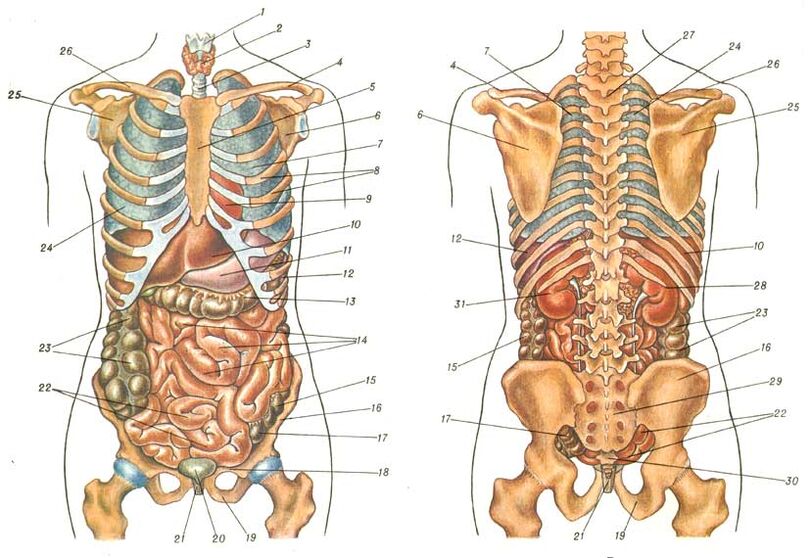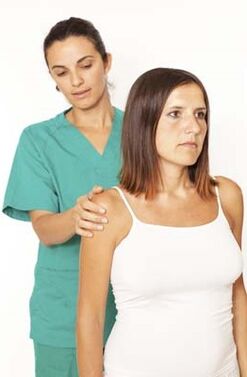Sometimes we experience discomfort in the back on the left side. There can be different types of pain - pulling, stabbing, aching. These may be accompanied by additional symptoms. Pain under the left shoulder blade is usually not the only symptom. This is one of the signs of the manifestation of any disease. All complaints and symptoms together help the doctor to choose the direction of the diagnosis. After all, immediate help is often needed.
The anatomical structure of the body
If we visualize our body from the back, it will be seen that the left shoulder blade is located on the ribs involved in the formation of the chest. Between the ribs are nerves and blood vessels. They are connected by muscle fibers.
The scapula performs the protective function of the internal organs - the heart, lungs, stomach and pancreas, spleen.
Based on the anatomical structure of the body, pain under the left shoulder blade can be conditionally divided into:
- related to the pathology of the locomotor system,
- related to the pathology of any internal organ.

Why are there unpleasant sensations on the left side
Many of us think of problems with the work of the heart when left-sided pain appears. In fact, more often the cause is a problem with the spine. Malfunctions may also occur in the work of internal organs.
Let's take a closer look at the causes of pain under the left shoulder blade. These can occur if:
- Spinal and musculoskeletal problems: osteochondrosis, intercostal neuralgia, scapular injuries, rib fractures, myofascial syndrome, Sprengel's disease.
- Diseases of the bronchi and lungs: pneumonia localized on the left side, dry pleurisy, bronchitis in the acute stage of the course, tracheitis, left lung abscess.
- Diseases of the cardiology system: angina pectoris, coronary artery disease, heart attack, valve prolapse.
- Diseases of the stomach and intestines: gastric and duodenal ulcer, gastroesophagitis, reflux, esophageal spasm.
- Psychosomatic course of the disease with vegetative-vascular dystonia.
The relationship between pain and illness
Patients can describe the nature of the pain from aching to cutting and burning. Pain has several characteristic signs that distinguish it from other diseases:
| The name of the disease | Pain that characterizes him |
|---|---|
| Heart diseases | The pain in the region of the left scapula is burning, causing a feeling of compression of the retrosternal space. It occurs in the same place, moving to the left - the back, shoulder blade, arm. With pressure, as if squeezing a heartache, it is possible for a heart attack to spread. In this case, urgent hospital treatment is required. |
| aortic aneurysm | The pain is sharp, shooting, growing, goes to the left in the back and under the shoulder blade. The condition develops rapidly and threatens the patient's life. |
| Pleurisy | The pain is sharp and stabbing, depending on the size of the breath. At rest, a tingling sensation is possible, when inhaling with a full chest, a stabbing pain occurs in the shoulder blade area. |
| Left sided pneumonia | The pain is not strong, aching, can be characterized as a point. It may increase slightly due to movement and deep inhalation. |
| Osteochondrosis of the vertebrae | Most often, the pain is localized at the base of the neck. It manifests itself in painful sensations, which are aggravated by sharp movements of the head. It can be accompanied by dizziness and numbness in the limbs. The pain under the shoulder blade is weak, aching, pulling, and the pain may increase after sitting for a long time or after physical exertion. This usually happens in the evening. In the morning, the stiffness of the spinal muscles is felt. Unlike heart pain, it does not go away after taking medication. There may be severe headaches that do not depend on pressure. |
| Diseases of the gastrointestinal tract, ulcers in the stomach and intestines | Pain in diseases of the gastrointestinal tract can be seasonal, with attacks. Pain syndrome can occur due to prolonged hunger, immediately after eating, a few hours after eating, at night. The pain disappears after the hunger is satisfied, after the food leaves the stomach, after vomiting or after taking medication. When the ulcer is perforated, the pain radiates under the left shoulder blade, is acute and unbearable. If you suspect this disease, go to the hospital immediately. At the beginning of the development of the disease, the pain may ease after vomiting. Accompanying symptoms of reflux esophagitis are heartburn, belching and impaired digestion. |
| Intercostal neuralgia | Sharp shooting or girdle pain is felt continuously or in fits. It can occur on one side. It increases during sudden movements - sneezing, coughing, severe shortness of breath, walking, physical activity, feeling the place of pain. |
| Vegetative-vascular dystonia and myofascial syndrome | In the case of myofascial syndrome, the pain is dull and comes from deep within the tissues. It can also occur at rest and during physical activity. Its intensity can range from mild to severe. Objectively, during the examination, patients with VVD suffer from irritability, memory loss, sweating, tachycardia and hand tremors. There are often changes in the heart muscle. The nature of the pain is similar to that of his heart. But an examination of the heart does not confirm the diagnosis. |
Diagnosis of the disease causing the pain syndrome

In order to find out what is causing the pain, a detailed examination will be necessary. First, you should consult a therapist or doctor. Based on the complaints and the examination of the patient, he determines the type of examination to be performed.
In the initial stages of treatment, if the pain radiates to the left shoulder blade, a trip to the local therapist should be made. You will be able to conduct an initial examination and prescribe any necessary tests. And already with the existing tests, you can consult with narrow specialists.
The doctor will not be able to diagnose the disease based solely on the complaints of the pain syndrome. Complaints give impetus in the direction where a more thorough diagnosis is needed. Therefore, when consulting a doctor, you must know exactly the answers to the nature, localization and simultaneous causes of the pain - the relationship with food intake, physical and emotional stress.
If myositis is suspected in a patient, a detailed blood test should be performed to confirm the inflammatory process.
For a more accurate diagnosis of the disease, a series of tests must be performed.
The first task is to rule out conditions requiring emergency medical care. These include: stomach and duodenal ulcer, heart attack, aortic rupture.
To understand what exactly hurts under the left shoulder blade, you need to do the following tests:
- Visual inspection and palpation of pain localization. Temperature, blood pressure and pulse are measured.
- X-ray in multiple views to confirm or rule out problems with the spine and lungs.
- EKG to check the work of the heart.
- In order to clarify the localization of the spinal problem, a CT scan or MRI may be necessary.
- If gastrointestinal problems are suspected, FGS can be prescribed - fibrogastroduodenoscopy.
- General and biochemical blood tests.
For certain types of pain, first aid can be provided with painkillers and antispasmodics. But taking them does not eliminate the cause, but only suppresses the pain on the left side, under the shoulder blade, which will surely return after the medicine expires. In order to prevent the recurrence of pain, it is necessary to find its cause.
In any case, if the left scapula hurts, a full examination should be carried out after the first signs of pain disappear. After all, the source of pain radiating towards the scapula can often be located elsewhere. Therefore, if a pain syndrome appears in the area of the scapula, it is necessary to visit: therapist, neurologist, cardiologist, gastroenterologist, traumatologist, excluding pathology from all the listed specialists. , consultation with a psychotherapist is required.
Treatment of the disease causing the pain syndrome

The goal of treatment depends on the diagnosis of the disease. There are separate treatment regimens for each disease. They necessarily include recommendations for physical activity and diet. The medication regimen is described in detail. Depending on the symptoms and complaints, they are combined to relieve acute symptoms that threaten the patient's life.
In any case, you should remember that pain in the left scapula can be removed only with medications recommended by a specialist. Do not resort to the advice of relatives and friends. After all, it is difficult to determine the nature of pain without medical help. Self-medication can lead to the delay of heart or stomach diseases.
- For example, in the case of reflux after the examination, medicines can be prescribed to reduce the acidity of the stomach and facilitate its movement in the intestines. In such cases, it is worth limiting the amount of food you eat, and you should not bow down immediately after eating.
- In case of osteochondrosis, physiotherapy exercises, swimming, dry heat and increased physical activity can be prescribed as medical procedures. All these measures are used as prophylaxis after the pain subsides.
- If ischemia is diagnosed, heart medication should be taken first. If the pain in the left shoulder blade does not go away after 10 minutes, you should call an ambulance.
- If cardiovascular problems arise, the best prevention is the continuous intake of the necessary medicines, diet, mental stability and not excessive physical activity.
- If the pain in the shoulder blade occurs due to spinal problems, it is necessary to perform special exercises for a long time and follow the recommendations of specialists regarding taking medications.
- If the pain under the left shoulder blade is associated with stomach and intestinal problems, diet and medication will help to cope. In this case, psycho-emotional balance is important, because stress often causes ulcers. A positive attitude, learning the relaxation technique is required.
If conservative treatment has no results, and if a perforated ulcer, large spinal hernia, or splenic rupture are detected, surgical intervention is necessary.
In principle, an annual medical examination is necessary to avoid serious health problems. It is necessary to carry out the necessary tests to rule out the occurrence of diseases in the near future.














































